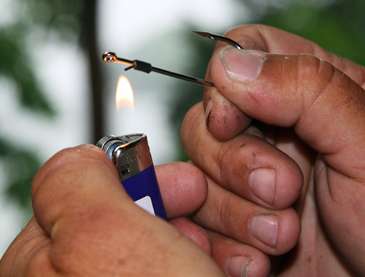
Terry “Big Show” Scroggins has three uses for a cigarette lighter and none of them involve tobacco. One involves tackle prep, one addresses rod repairs and the last one extends plastic bait life. All present insightful wisdom that will keep anglers in the game and fishing efficiently.
For starters, Scroggins is a noted tinkerer, so it’s no surprise that he makes his own bait keepers. He starts with a bare 5/0 spinnerbait hook — preferred for its strength — and clips a 1/4-inch section of spinnerbait wire to form the keeper.
He positions the wire on the hook shank to allow room for his snell knot, then he slides a 1/4-inch piece of heat-shrink tubing (the kind with interior glue) over the bottom half of the keeper, applies the lighter’s flame for a few seconds and, voila — homemade bait keeper.
Scroggins notes this operational point: “It’s important to bend the wire before cutting out your piece (for the bait keeper), because you have more leverage than you will with a small piece that’s hard to hold.”
One of the most common gear damages for anglers is a broken rod tip. Truck doors, ceiling fans, ill-placed feet, the causes are many, but what if you desperately need that broken rod before you can get it repaired? If you’re Terry Scroggins, you’ll grab your trusty lighter, heat the end of a similar sized rod and transplant the tip on the one with the needed action.
Of course, rod guides break too, so Scroggins plans ahead by stripping the guides and tips off his retired rods and keeping these components handy. Heating the wraps loosens the original bindings enough to remove damaged guides. Scroggins secures the replacements with 6-pound fluorocarbon topped with super glue.
“If you’ve fished, you’ve broken rods at some point, and spare rod tips and guides are something you can easily keep in your boat,” Scroggins noted. “They don’t take up a lot of room, and when the day comes that you need them, you’ve got them sitting there.”
Avoid overdoing it with the heat. If you see smoke, you’ve gone way too far. Think scalpel, not chainsaw.
“Be careful not to heat your rod too much because it will weaken the rod,” Scroggins said. “The rod will start to discolor (after excessive heating). You don’t want to heat it more than about 5 seconds. It doesn’t’ take much at all.”
Lastly, Scroggins knows that sometimes the bass only want a certain color of a particular soft plastic. The good thing about an active bite is, well, it’s an active bite. However, the downside is that you’ll often burn through your supply and reach that dreadful moment of realizing the fish are still biting, but you’re out of ammo.
Not to worry, says Scroggins. Just keep those torn pieces and perform a little waterside reconstructive surgery.
“If you get out there and you have one pack of worms and they get to biting on them really good, you may run out when the bass tear them in half,” Scroggins said. “But you can take that lighter and put some of those worms back together and keep fishing. Plastic heats up really quickly and it cools down really quickly, so it doesn’t take long.”
Although he’s not particular about brands or styles, Scroggins takes care to protect his lighters from rain or impact damage by storing them in his flipping tackle tray. Safe and orderly storage keeps the tool ready for action.
“A lighter is very important,” Scroggins said. “If you have a lighter, a bottle of super glue, and a roll of duct tape or electrical tape, you can fix a lot of things on your boat.”
And when those rigging or repair moments arise during inclement weather, Scroggins has a fix for that, too.
“If it’s extremely windy or rainy, I lay a rain coat over my steering wheel to make a canopy so I can stay out of the wind or rain,” he said. “It’s only going to take about 5 to 8 seconds with the lighter to do whatever you need to do.”





